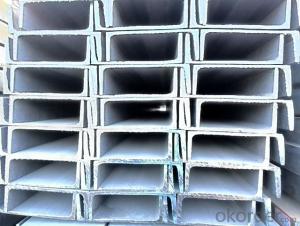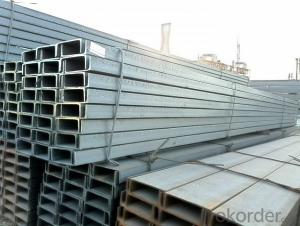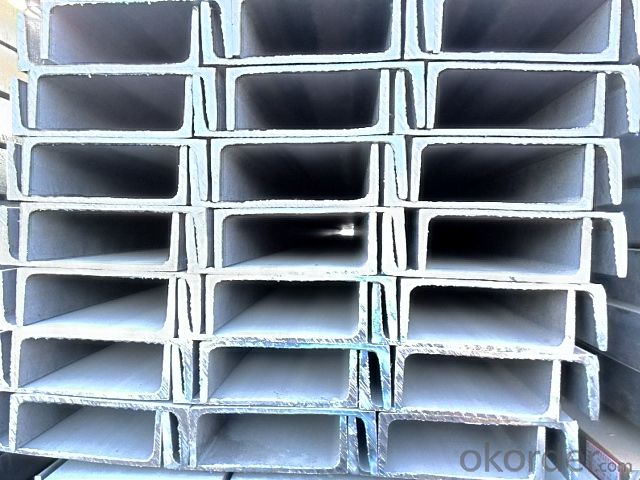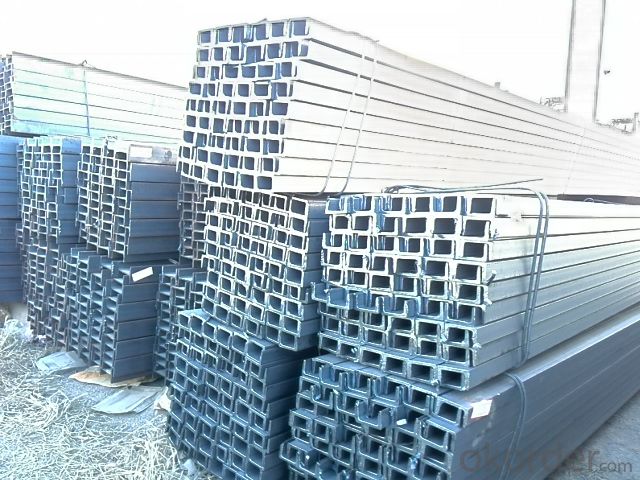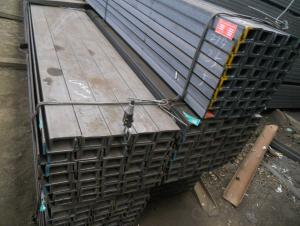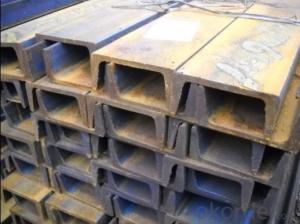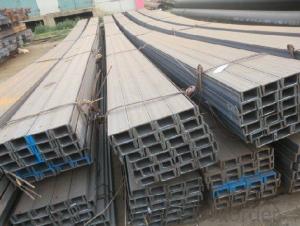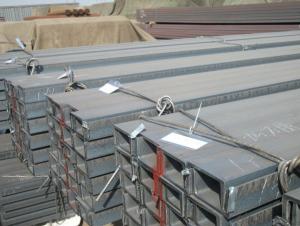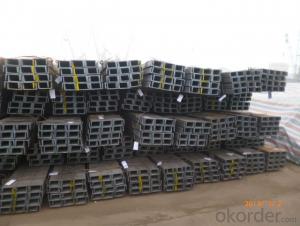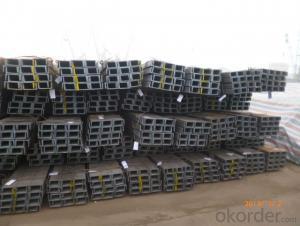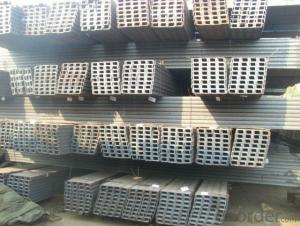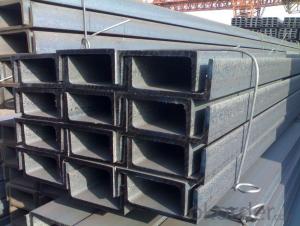Hot Rolled U-Channels with Best Price and Quality
- Loading Port:
- Tianjin
- Payment Terms:
- TT OR LC
- Min Order Qty:
- 25 m.t
- Supply Capability:
- 10000 m.t/month
OKorder Service Pledge
OKorder Financial Service
You Might Also Like
Specification
Okorder.com is a professional materials & equipment supplier & manufacturer, offers integrated one-stop services including real-time quoting and online cargo tracking. We are funded by CNBM Group, a Fortune 500 enterprise and the largest materials & equipment firm in China.
Product Applications:
The MS Channel can be applied to construction of warehouses, workshops, sport stadiums and car parks etc.The hot rolled channel steel belongs to carbon structural steel which is applied to in the field of construction and machinery.In details, the hot rolled channel steel is usually used for arch-itechtural structure, and they could be welded in order to support or hang a vari-ety of facilities. They are also usually used in combination with I beam. Generally,the hot rolled channel steel we supply must possess perfect welding property, riveting property and mechanical property and so on.
Product Advantages:
OKorder's Steel U-Channels are durable, strong, and resist corrosion.
Main Product Features:
· Premium quality
· Prompt delivery & seaworthy packing (30 days after receiving deposit)
· Corrosion resistance
· Can be recycled and reused
· Mill test certification
· Professional Service
· Competitive pricing
Product Specifications:
1.We supply high quality MS Channel at reasonable price, including Chinese standard, Japanese standard and so on.
Standard | GB/JIS |
Material Grade | Q235,SS400 |
Technique: | Hot Rolled |
Sizes as per chinese standard: | 50*37*4.5mm - 300*89*11.5mm |
Sizes as per japanese standard: | 50*25*3mm – 200*80*7.5mm |
Length: | 6meter, 9meter, 12meter |
Note: 1.we are also competent to provide our customers other MS Channel based on other sizes according to customer’s requirements.
2. The length of our ms channel could be cut into other meters as per customer’s requirements. For example, the channel in 6meters could be cut into 5.8meters in order to be fit in the 20ft container.
2. The detailed sections of MS Channel as per GB standard.are shown in the table-1:
GB U CHANNEL | Standard | Sectional | Dimension |
| Mass: |
(mm) | (mm) | (mm) | (mm) | ||
50X37 | 50 | 37 | 4.50 | 7.0 | 5.438 |
63X40 | 63 | 40 | 4.80 | 7.5 | 6.634 |
80x43 | 80 | 43 | 5.00 | 8.0 | 8.045 |
100x48 | 100 | 48 | 5.30 | 8.5 | 10.007 |
120x53 | 120 | 53 | 5.50 | 9.0 | 12.059 |
140x58 | 140 | 58 | 6.00 | 9.5 | 14.535 |
140x60 | 140 | 60 | 8.00 | 9.5 | 16.733 |
160x63 | 160 | 63 | 6.50 | 10.0 | 17.240 |
160x65 | 160 | 65 | 8.50 | 10.0 | 19.752 |
180x68 | 180 | 68 | 7.00 | 10.5 | 20.174 |
180x70 | 180 | 70 | 9.00 | 10.5 | 23.000 |
200x73 | 200 | 73 | 7.00 | 11.0 | 22.637 |
200x75 | 200 | 75 | 9.00 | 11.0 | 25.777 |
220x77 | 220 | 77 | 7.00 | 11.5 | 24.999 |
220x79 | 220 | 79 | 9.00 | 11.5 | 28.453 |
250x78 | 250 | 78 | 7.00 | 12.0 | 27.410 |
250x80 | 250 | 80 | 9.00 | 12.0 | 31.335 |
250x82 | 250 | 82 | 11.00 | 12.0 | 35.260 |
280x82 | 280 | 82 | 7.50 | 12.5 | 31.427 |
280x84 | 280 | 84 | 9.50 | 12.5 | 35.823 |
280x86 | 280 | 86 | 11.50 | 12.5 | 40.219 |
300x85 | 300 | 85 | 7.50 | 13.5 | 34.463 |
300x87 | 300 | 87 | 9.50 | 13.5 | 39.173 |
300x89 | 300 | 89 | 11.50 | 13.5 | 43.883 |
Table-1
FAQ:
Q1: Why buy Materials & Equipment from OKorder.com?
A1: All products are carefully selected from China's most reliable manufacturing enterprises. Through its ISO certifications, OKorder.com adheres to the highest standards and a commitment to supply chain safety and customer satisfaction. We can guarantee the quality!
Q2: The products are invoicing on theoretical weight or on actual weight?
A2: We can do it in both manners, it’s according to buyer's requirement.
Q3: Can you offer the third part inspection certificates ?
A3: We are able to present our customers relevant SGS test report for mechanical property of MS Channel as customer’s request.
Images:
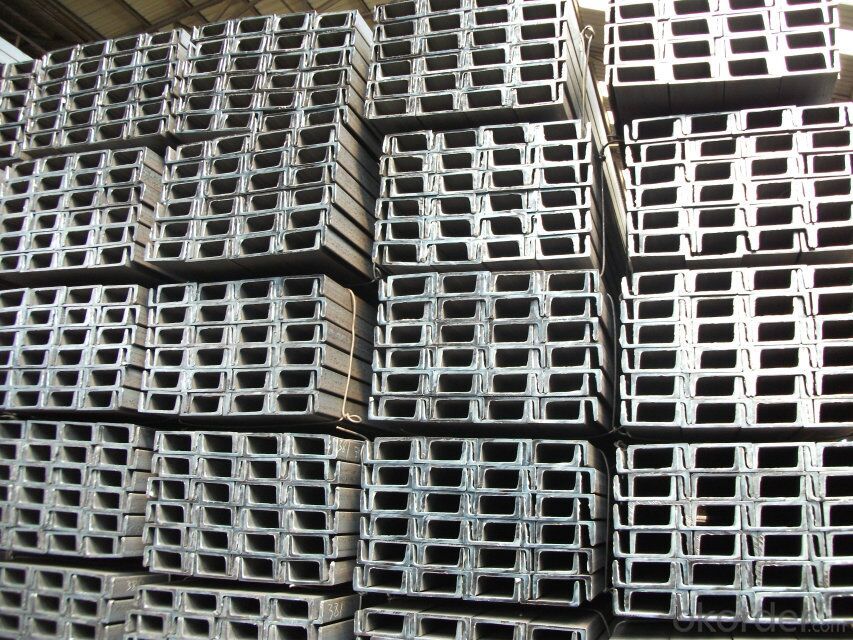
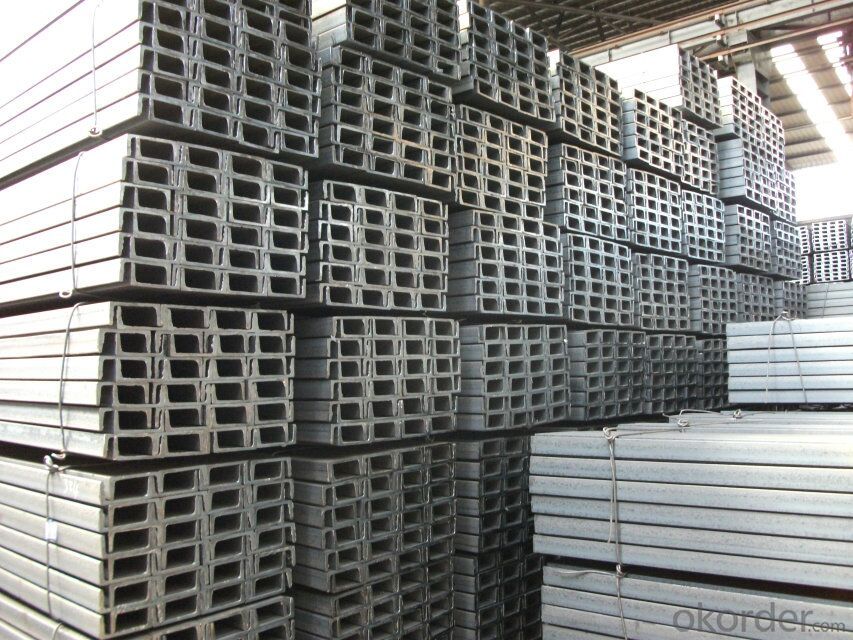
- Q: How do you calculate the deflection of steel channels?
- To calculate the deflection of steel channels, you need to consider various factors such as the material properties, dimensions, loading conditions, and support conditions. The deflection of a steel channel can be determined using the principles of structural mechanics and beam theory. Here is a step-by-step process to calculate the deflection: 1. Determine the material properties: Obtain the modulus of elasticity (E) and the moment of inertia (I) of the steel channel. These values can be obtained from material specifications or reference manuals. 2. Determine the dimensions: Measure or obtain the dimensions of the steel channel, including the height (h), width (b), and thickness (t). These measurements are necessary to calculate the moment of inertia. 3. Determine the loading conditions: Identify the applied loads, such as point loads, distributed loads, or moments, acting on the steel channel. Determine the magnitude and location of these loads. 4. Identify the support conditions: Determine whether the steel channel is simply supported, fixed at both ends, or has other support conditions. This information is critical to determine the appropriate boundary conditions for the deflection calculation. 5. Determine the type of beam equation to use: Based on the loading and support conditions, select the appropriate beam equation to calculate the deflection. Common equations include the Euler-Bernoulli beam equation or the Timoshenko beam equation. 6. Apply the beam equation: Substitute the appropriate values into the selected beam equation. This equation relates the deflection (δ) to the applied loads, material properties, and dimensions of the steel channel. 7. Solve the beam equation: Depending on the complexity of the loading and support conditions, you may need to solve the beam equation analytically, numerically, or using software tools. Analytical solutions are available for simple loading and support conditions, while numerical methods or software tools may be necessary for more complex scenarios. 8. Calculate the deflection: Once you have solved the beam equation, you can calculate the deflection of the steel channel at specific points or along its entire length. The deflection is typically measured in units of length (e.g., inches or millimeters). It is important to note that calculating the deflection of steel channels is a complex process, and it is recommended to consult relevant engineering codes, standards, or reference materials for detailed equations and procedures specific to your application. Additionally, consider seeking assistance from a qualified structural engineer for accurate and reliable results.
- Q: Are steel channels suitable for modular partition systems?
- Yes, steel channels are suitable for modular partition systems. Steel channels provide structural strength and stability required for modular partitions, allowing for easy installation and customization. They also offer durability and can withstand the weight of partition panels, ensuring long-lasting performance. Additionally, steel channels can be easily integrated with other components of the partition system, making them a suitable choice for modular applications.
- Q: How do steel channels perform in high-temperature environments?
- Steel channels typically perform well in high-temperature environments due to their inherent strength and durability. The properties of steel, such as its high melting point and resistance to thermal expansion, make it suitable for use in elevated temperatures. Steel channels can withstand high temperatures without significant deformation or loss of structural integrity. One of the main reasons steel channels are effective in high-temperature environments is their ability to retain their mechanical properties at elevated temperatures. Steel has a high thermal conductivity, which allows it to effectively dissipate heat and prevent excessive temperature rise. This property helps to maintain the structural stability of steel channels even when exposed to high heat. Moreover, steel channels are often designed to have a high fire resistance rating. This is achieved by incorporating fire-resistant coatings or fireproofing materials to enhance their performance in extreme temperatures. These measures help to protect the steel channels from the detrimental effects of heat, including weakening or deformation. It is important to note that the performance of steel channels in high-temperature environments can be influenced by factors such as the specific grade of steel used and the duration of exposure to elevated temperatures. Different grades of steel have varying thermal properties, so it is crucial to select the appropriate grade based on the specific temperature requirements of the application. In summary, steel channels generally perform well in high-temperature environments. Their strength, durability, and ability to retain mechanical properties make them suitable for use in such conditions. However, it is recommended to consult with experts or refer to the manufacturer's specifications to ensure the steel channels are selected and utilized correctly for optimal performance in high-temperature environments.
- Q: What are the different methods for protecting steel channels from water intrusion?
- There are several methods for protecting steel channels from water intrusion. One common method is to apply a waterproof coating or sealant on the surface of the channels. This creates a barrier that prevents water from penetrating into the steel. Another method is to use weatherproof gaskets or seals between the joints of the channels to ensure a tight and secure fit, preventing water from entering. Additionally, proper drainage systems and slope design can help divert water away from the channels, reducing the risk of water intrusion. Regular inspections and maintenance are also crucial to identify and address any potential vulnerabilities or damages that could lead to water penetration.
- Q: How do steel channels contribute to the ease of construction?
- There are several ways in which steel channels contribute to the ease of construction. Firstly, they offer structural support and stability to various building components. These channels are specifically designed to withstand heavy loads and provide a solid framework for the overall structure, making them perfect for constructing beams, columns, and joists. In addition, steel channels are highly versatile and can be easily customized to meet specific construction requirements. They are available in various sizes and shapes, allowing for flexibility in design. This adaptability makes them suitable for a wide range of construction projects, whether it is for industrial buildings, bridges, or residential structures. Furthermore, steel channels are lightweight in comparison to other construction materials like concrete. This makes them much easier to handle and transport on construction sites, reducing the need for heavy machinery and manpower. The lightweight nature of steel channels also simplifies the construction process as a whole, minimizing the time and effort needed for installation. Moreover, steel channels are incredibly durable and resistant to various environmental factors, including corrosion, fire, and termites. This durability ensures that the structure remains stable and secure over time, reducing the need for frequent repairs or replacements. Additionally, it contributes to the overall sustainability of the construction industry by minimizing waste and promoting long-term use. In conclusion, steel channels play a crucial role in facilitating easy construction by offering structural support, design versatility, ease of handling, and durability. These qualities make them an essential component in modern construction, enhancing the overall efficiency and reliability of the construction process.
- Q: I encountered in the construction of 2 short 28# channel welding, processed into beams, how to weld? Do I have to have stiffened panels? How many pieces? What's the thickness of the stiffener? I heard that there is a book called "metal processing manual", which has instructions, but I do not have the book. Please give settlement.
- If the gap between the two weldment is not conducive to welding, it can be welded with a piece of steel plate. If the assembly gap is reasonable, direct rust removal and welding can be done.
- Q: Can steel channels be used in high-temperature applications?
- Yes, steel channels can be used in high-temperature applications. Steel channels are known for their excellent resistance to high temperatures, making them suitable for various industrial applications such as furnaces, boilers, and heat exchangers. The high melting point and thermal stability of steel channels allow them to maintain their structural integrity and performance under high-temperature conditions.
- Q: How do steel channels perform in extreme temperature conditions?
- Steel channels perform well in extreme temperature conditions due to their high thermal conductivity and low thermal expansion coefficient. This means that steel channels are able to efficiently transfer heat and cold, allowing them to maintain their structural integrity and stability in extreme temperature environments. Additionally, steel channels have a high melting point, which makes them resistant to deformation or structural failure even at high temperatures. The strength and durability of steel also contribute to its performance in extreme temperature conditions, as it is less likely to warp, bend, or crack under thermal stress. Overall, steel channels are a reliable choice for applications requiring stability, strength, and resistance to extreme temperatures.
- Q: Can steel channels be used for architectural detailing?
- Certainly, architectural detailing can make use of steel channels. These channels are highly adaptable and frequently employed in architectural contexts owing to their robustness, longevity, and visual allure. They find utility in multiple architectural detailing components, including window frames, door frames, curtain walls, handrails, and other structural elements. Steel channels provide a polished and contemporary aesthetic, while their capacity to bear substantial loads renders them ideal for architectural endeavors. Furthermore, they can be readily tailored and manufactured to satisfy precise design prerequisites, rendering them a favored selection in architectural detailing.
- Q: How do steel channels perform under earthquake loads?
- Steel channels are known for their excellent strength and ductility, which allows them to perform well under earthquake loads. The structural integrity and stiffness of steel channels help to effectively resist seismic forces and minimize damage. They can absorb and distribute the energy generated during an earthquake, reducing the chances of collapse or failure. Additionally, steel channels can be designed and reinforced to withstand specific seismic conditions, making them a reliable choice for earthquake-resistant structures.
Send your message to us
Hot Rolled U-Channels with Best Price and Quality
- Loading Port:
- Tianjin
- Payment Terms:
- TT OR LC
- Min Order Qty:
- 25 m.t
- Supply Capability:
- 10000 m.t/month
OKorder Service Pledge
OKorder Financial Service
Similar products
Hot products
Hot Searches
Related keywords
